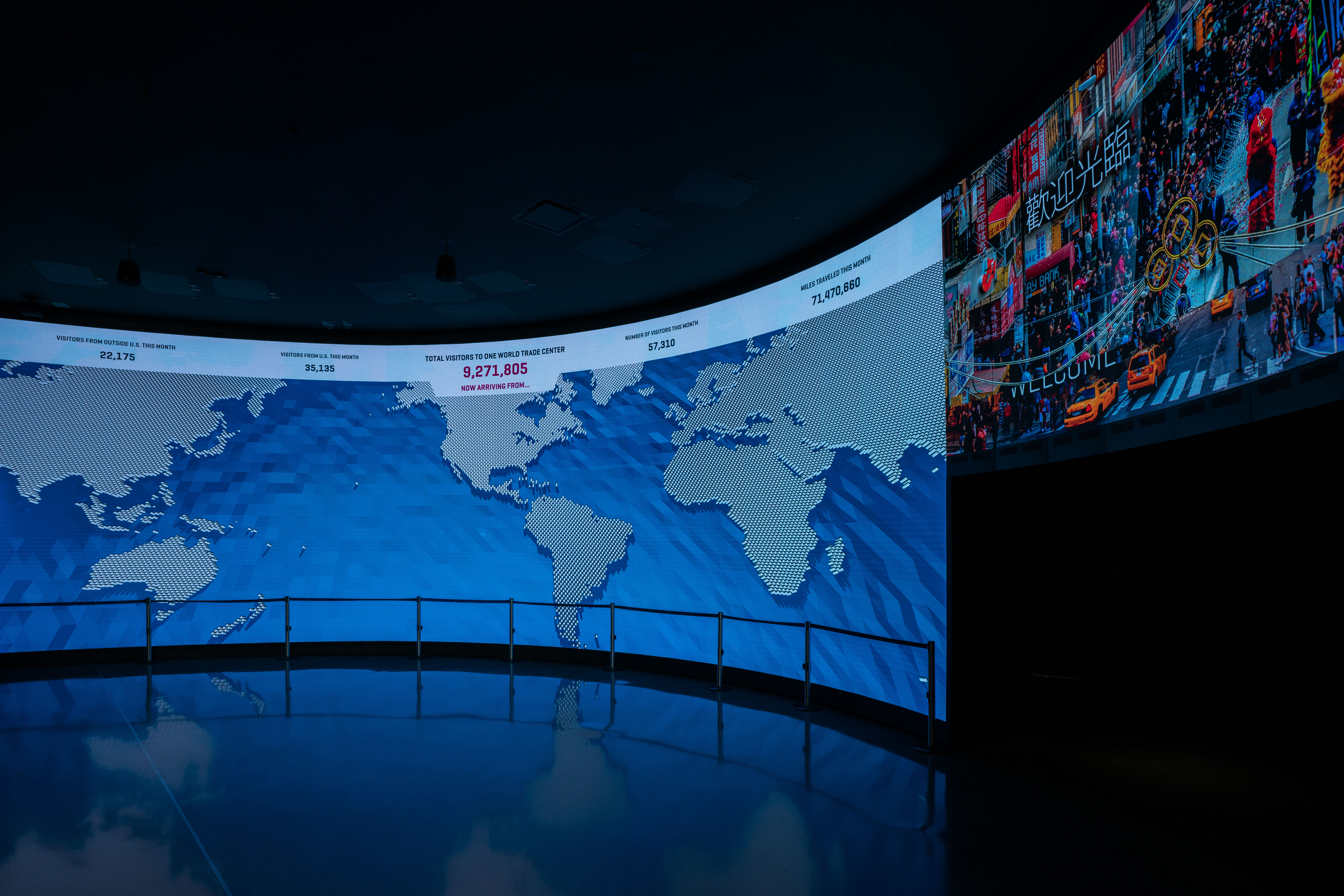From broadcast studios to museums to corporate reception areas, an increasing number of organizations are using curved video walls to create eye-catching experiences for their customers. Curved video walls allow organizations to design installations that better fit their architectural spaces and create a “wow” factor that was impossible to achieve even just a few years ago.
The technology enabling curved LED displays has matured over the last few years, making it possible to create video walls that bend and curve in different ways, capturing people’s peripheral vision and captivating viewers with highly immersive experiences. Today’s cutting-edge technology enables organizations to build installations of almost any size, shape, and curvature—from video walls that wrap around columns to 360-degree displays that surround the viewer.
[The Integration Guide to Video Walls 2020]
As display technology advances and prices continue to fall, many organizations are removing their outdated rear-projection cube video walls or tiled LCD video walls and replacing them with curved video walls, which offer dynamic experiences that delight viewers and strengthen the organization’s brand.
Implementing Curved LED Walls
Curved LED video walls are typically implemented in one of two ways: a series of flat LED cabinets can be faceted together at slight angles to achieve a curved effect, or flexible LED modules can be bent to form smooth concave and convex curves. Which option an organization chooses depends on its budget and project goal. For organizations with tight budgets, faceted flat cabinets offer the more cost-effective option, yet there are many situations where flexible, bendable modules are clearly the better choice.
Faceted Cabinets vs. Flexible Modules
Here are three factors organizations need to think about when choosing between faceted cabinets and flexible modules.
The Curve Radius: The first thing to consider is the radius of the curve. In a space with gradual curves, faceting a series of rigid, flat LED cabinets creates a professional looking curved effect. But in an area with tight curves, the cabinet-to-cabinet angle will be too high, resulting in color shift when viewing the video wall from different angles. For example, the video wall may appear reddish from one side and blueish from the other, making the color imbalanced. For the best visual experience, keeping the cabinet-to-cabinet angle below 3 degrees is recommended. Angles between 3 and 6 degrees can also look good depending on the content displayed, while angles greater than 6 degrees usually require flexible LED modules.
[The State of Digital Signage]
The Content Displayed: When deciding between faceted cabinets and flexible modules, it’s important to consider what information you want to display. If you’re planning to showcase videos and motion graphics, this content is more forgiving—color shift and facet seams are less of an issue. Spreadsheets and PowerPoint presentations are less forgiving, however. If the video wall is a museum display showcasing videos, for example, faceted cabinets may work just fine, but if the subject matter will be detailed spreadsheets, flexible modules may be the better option.
The Viewing Distance and Angle: Organizations should also consider where viewers will be in relation to the video wall—both how close they will be and whether the wall will be off to the side or directly in front of them. For content that needs to be viewed up close, smaller pixel pitches will yield a sharper image. Today’s flat LED cabinets offer the lowest pixel pitches: The current minimum is 0.7 millimeters, compared to 1.5 millimeters for flexible modules. If people will be viewing the video wall from different angles, the organization must also consider the curve radius. In general, if the curve is gradual and viewers will be standing close to the video wall, faceted cabinets should be sufficient to pull off the effect, but if it’s a tightly curved space with people standing off to the side, the installation may require flexible modules.
Real-World Examples

One organization that chose to employ flexible modules in its video wall solution is TF1, a French free-to-air television channel. Plans for the upgrade of the broadcaster’s Paris news studio called for the installation of a 70-square-meter video wall with both curved and flat segments. TF1 combined 1.9-millimeter flexible modules for the wall’s curved areas and standard 1.9-millimeter rigid LED cabinets for the flat areas, creating an impressive video wall with smooth curves and no visible color shift for viewers.
Alternately, integrators deployed faceted cabinets for a gently curving video wall in One World Trade Center in Lower Manhattan. Located in the Global Welcome Center, from which visitors take an elevator to the three-story observation deck at the top of the building, the video wall is an expansive, floor-to-ceiling Planar TVF Series installation composed of faceted 1.8mm-pixel-pitch flat LED cabinets. The video wall was installed in 2019, replacing a large projector system display that was difficult to maintain and didn’t quite meet the needs of the visitor center. The video wall is so large and the curve is so gradual that there was no need for flexible LED modules.

With the curved video wall in place, visitors who enter One World Observatory’s welcome center are greeted by a large world map that transforms into a rotating globe at regular intervals. When tourists purchase tickets, their hometown is highlighted on the map, along with graphics showing the relative number of visitors from other parts of the world.
Video walls, a common sight in corporate environments, are making a lasting impression on customers. Curved video walls add a new level of “wow” by delivering unique, sophisticated visual experiences. By implementing curved installations, organizations can bring their spaces to life—creating memorable experiences that go beyond what was possible previously to boost their brand and transform their results.
To read more about video walls, download the 2020 Digital Signage Best Practices Guide.
